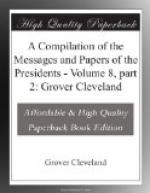James D. Richardson.
July 4, 1898.
James A. Garfield
March 4, 1881, to September 19, 1881
James A. Garfield
James Abram Garfield was born in Orange, Cuyahoga County, Ohio, November 19, 1831. His father, Abram Garfield, was a native of New York, but of Massachusetts ancestry; descended from Edward Garfield, an English Puritan, who in 1630 was one of the founders of Watertown. His mother, Eliza Ballou, was born in New Hampshire, of a Huguenot family that fled from France to New England after the revocation of the Edict of Nantes in 1685. Garfield, therefore, was from lineage well represented in the struggles for civil and religious liberty, both in the Old and in the New World. His father moved to Ohio in 1830 and settled in what was then known as the “Wilderness,” now as the “Western Reserve,” which was occupied by Connecticut people. He died at the age of 33, leaving a widow and four small children, of whom James was the youngest. Mrs. Garfield brought up her family unaided, and impressed upon them a high standard of moral and intellectual worth. James attended school in a log hut at the age of 3 years, learned to read, and began that habit of omnivorous reading which ended only with his life. At 10 years of age was accustomed to manual labor, helping out his mother’s meager income by work at home or on the farms of the neighbors. Attended the district school in the winter months, made good progress, and was conspicuous for his assiduity. At the age of 14 had a fair knowledge of arithmetic and grammar, and was particularly apt in the facts of American history. His imagination was especially kindled by tales of the sea, and he so far yielded to his love of adventure that in 1848 he went to Cleveland and proposed to ship as a sailor on board a lake schooner. Seeing that this life was not the romance he had conceived, he turned promptly from the lake; but loath to return home without adventure and without money, he drove some months for a boat on the Ohio Canal, when he was promoted from the towpath to the boat. Attended the Geauga Seminary at Chester, Ohio, during the winter of 1849-50. In the vacations learned and practiced the trade of a carpenter, helped at harvest, taught—did anything and everything to earn money to pay for his




